
Fra Angelico, O.P. was a Dominican friar and Italian Renaissance painter of the Early Renaissance, described by Giorgio Vasari in his Lives of the Artists as having "a rare and perfect talent". He earned his reputation primarily for the series of frescoes he made for his own friary, San Marco, in Florence, then worked in Rome and other cities. All his known work is of religious subjects.

Filippino Lippi was an Italian Renaissance painter mostly working in Florence, Italy during the later years of the Early Renaissance and first few years of the High Renaissance. He also worked in Rome for a period from 1488, and later in the Milan area and Bologna.

Tommaso di Cristoforo Fini, known by his nickname Masolino da Panicale, was an Italian painter. His best known works are probably his collaborations with Masaccio: Madonna with Child and St. Anne (1424) and the frescoes in the Brancacci Chapel (1424–1428).

Lorenzo Lotto was an Italian Renaissance painter, draughtsman, and illustrator, traditionally placed in the Venetian school, though much of his career was spent in other north Italian cities. He painted mainly altarpieces, religious subjects and portraits. He was active during the High Renaissance and the first half of the Mannerist period, but his work maintained a generally similar High Renaissance style throughout his career, although his nervous and eccentric posings and distortions represented a transitional stage to the Florentine and Roman Mannerists.

Pietro Lorenzetti or Pietro Laurati was an Italian painter, active between c. 1306 and 1345. Together with his younger brother Ambrogio, he introduced naturalism into Sienese art. In their artistry and experiments with three-dimensional and spatial arrangements, the brothers foreshadowed the art of the Renaissance.

The Basilica dei Santi Giovanni e Paolo, known in Venetian as San Zanipolo, is a Catholic minor basilica and Dominican conventual church in the Castello sestiere of Venice, Italy.
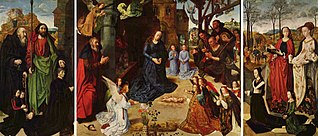
The Portinari Altarpiece or Portinari Triptych is an oil-on-wood triptych painting by the Flemish painter Hugo van der Goes, commissioned by Tommaso Portinari, representing the Adoration of the Shepherds. It measures 253 x 304 cm, and is now in the Galleria degli Uffizi in Florence, Italy. This altarpiece is filled with figures and religious symbols. Of all the late-fifteenth-century Flemish artworks, this painting is said to be the most studied.

The Dominican Church, also known as the Church of St. Maria Rotunda, is an early Baroque parish church and minor basilica in the historic center of Vienna, Austria. It is the third church built on the same site in the course of time.
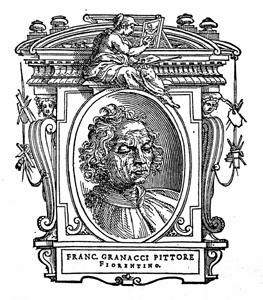
Francesco Granacci was an Italian Renaissance painter active primarily in his native Florence. Though little-known today, he was regarded in his time and is featured in Giorgio Vasari's Lives of the Artists.

The Sassetti Chapel is a chapel in the basilica of Santa Trinita in Florence, Italy. It is especially notable for its frescoes of the Stories of St. Francis, considered Domenico Ghirlandaio's masterwork.
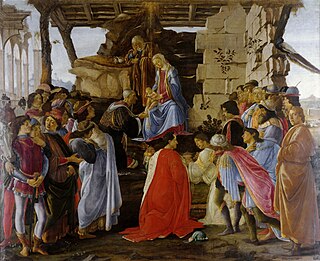
The Adoration of the Magi is a painting by the Italian Renaissance master Sandro Botticelli. Botticelli painted this piece for the altar in Gaspare di Zanobi del Lama's chapel in Santa Maria Novella around 1475. This painting depicts the Biblical story of the Three Magi following a star to find the newborn Jesus. The image of the altarpiece centers on the Virgin Mary and the newborn Jesus, with Saint Joseph behind them. Before them are the three kings who are described in the New Testament story of the Adoration of the Magi. The three kings worship the Christ Child and present him with gifts of gold, frankincense and myrrh. In addition, the Holy Family is surrounded by a group of people who came to see the child who was said to be the son of God.

The church of San Pietro da Verona in Santa Anastasia, better known as the basilica of Santa Anastasia, is an important Catholic place of worship that stands in the heart of the historic center of Verona; it is located at the end of the decumanus maximus of the city in Roman times, near the point where the wide meander of the Adige river is crossed by the Ponte Pietra, where the two main traffic routes of the city, road and river, gravitate. It is the largest, most solemn and representative church in Verona, a reflection of a lively moment in the city's life, when the expansion and consolidation of political and economic institutions allowed the community, in synergy with the Scaliger rule, the Dominican clergy and the Castelbarco family, to make a considerable financial effort to build this important temple, a symbol of their power.
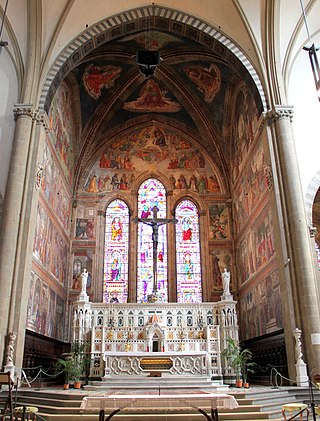
The Tornabuoni Chapel is the main chapel in the church of Santa Maria Novella, Florence, Italy. It is famous for the extensive and well-preserved fresco cycle on its walls, one of the most complete in the city, which was created by Domenico Ghirlandaio and his workshop between 1485 and 1490.
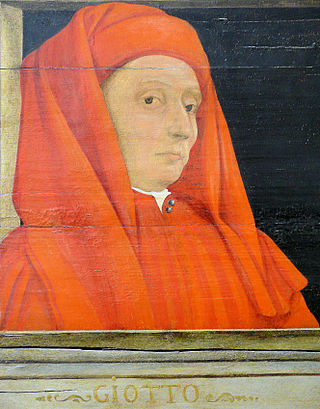
Giotto di Bondone, known mononymously as Giotto, was an Italian painter and architect from Florence during the Late Middle Ages. He worked during the Gothic and Proto-Renaissance period. Giotto's contemporary, the banker and chronicler Giovanni Villani, wrote that Giotto was "the most sovereign master of painting in his time, who drew all his figures and their postures according to nature" and of his publicly recognized "talent and excellence". Giorgio Vasari described Giotto as making a decisive break from the prevalent Byzantine style and as initiating "the great art of painting as we know it today, introducing the technique of drawing accurately from life, which had been neglected for more than two hundred years".

The Coronation of the Virgin is a painting by the Italian early Renaissance master Fra Angelico, executed around 1434–1435 in Fiesole (Florence). It is now in the Musée du Louvre of Paris, France. The artist executed another Coronation of the Virgin, now in the Uffizi in Florence.

The Bartolini Salimbeni Chapel is a chapel in the church of Santa Trinita, Florence, central Italy. Its decoration by Lorenzo Monaco, dating to the 1420s, are one of the few surviving examples of International Gothic frescoes in Italy. The chapel has kept other original elements, such as its altarpiece, an Annunciation, also by Monaco, and the railings.

The Saint Vincent Ferrer Altarpiece is a tempera-on-panel painting by Giovanni Bellini, dating to 1464–1470 and still in on the altar dedicated to Saint Vincent Ferrer at Santi Giovanni e Paolo, Venice, for which it was originally commissioned. Ferrer was a Spanish Dominican who had only been canonised in 1455 and his order was continuing to promote his cult.

Adoration of the Christ Child is a tempera on panel altarpiece by Filippo Lippi, originally painted for the church of San Domenico in Prato and now in the city's Museo Civico. It is also known as Adoration of the Christ Child with St Vincent Ferrer or Nativity with St George and St Vincent Ferrer. It was painted between 1455 and 1466. The work was probably damaged by a fire in the church in 1467, requiring some repairs which were discovered in a recent restoration of the work.

Portrait of a Man is an oil on panel painting by Rosso Fiorentino, created c. 1522. it is held in the National Gallery of Art, in Washington, DC.

The Madonna del Popolo is an oil on wood painting by Italian painter Federico Barocci, created in 1575-1579. It depicts the Madonna and the works of mercy. It is signed and dated FEDERICVS BAROTIVS VRBINAS MDLXXIX. It is held in the Uffizi, in Florence.





















